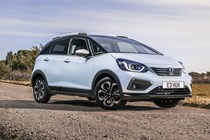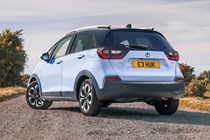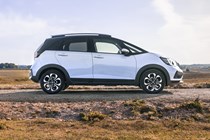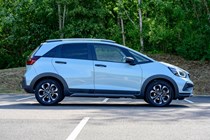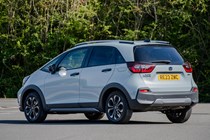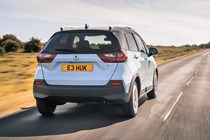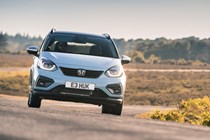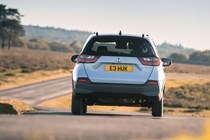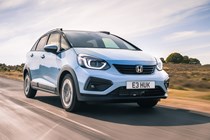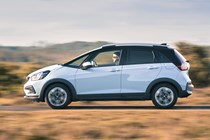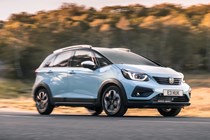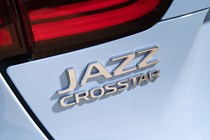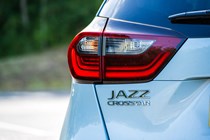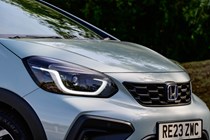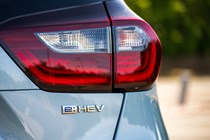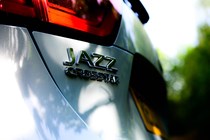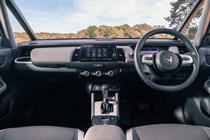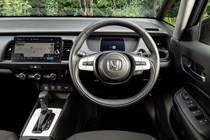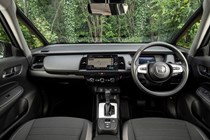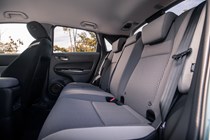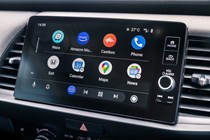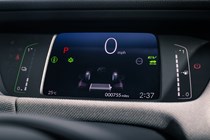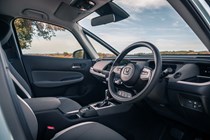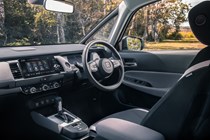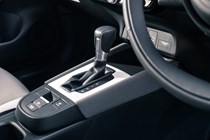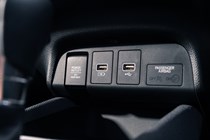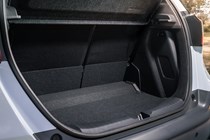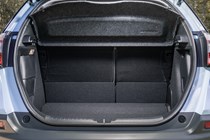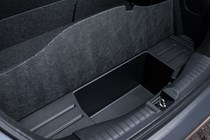
Honda Jazz Crosstar (2020-2023) long-term test
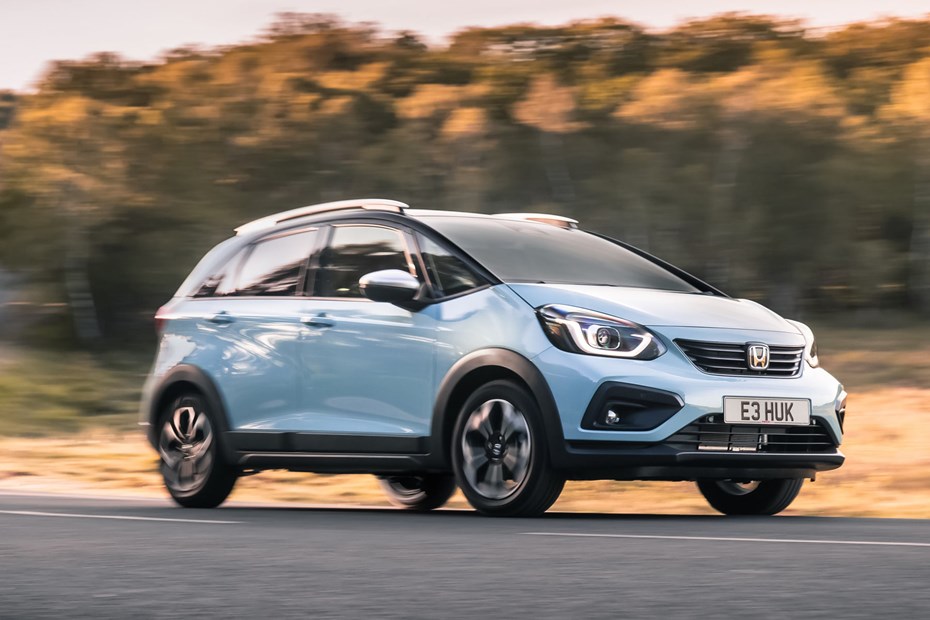
We lived with a Honda Jazz Crosstar for six months, evaluating what it’s like to own and drive it every day. The full report follows, or you can skip to the updates you’re interested in below.
Month two: Even the excesses of Christmas barely trouble our Honda Jazz – sci-fi meets sorcery with ‘magic’ seats and TARDIS-like levels of interior space
Month three: Beautiful on the inside – life with our Honda Jazz is pretty wonderful from the (water-resistant) driver’s seat
Month four: The Jazz has many talents, but is driving well one of them? We find out
Month five: Who’s the Honda Jazz Crosstar really for? We try to figure out whether it’s a better bet than other hybrid hatchbacks
Month six: We say a sad goodbye to the Honda Jazz Crosstar – it’s been a surprise hit among the Parkers team
First report: Welcome
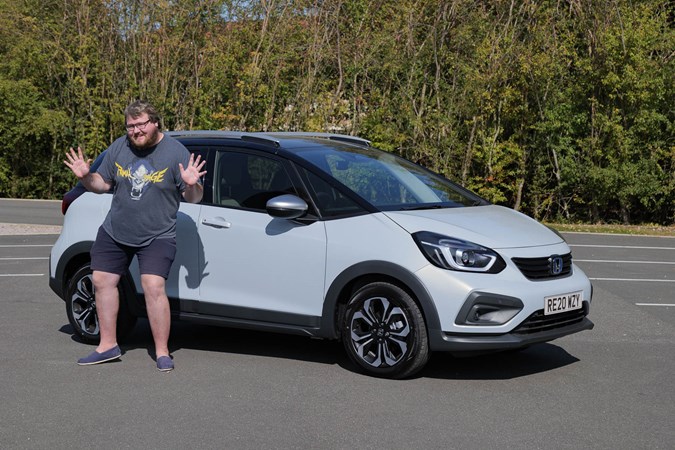
The golden age of Jazz was the 1920s, which coincidentally is when most buyers of the Honda Jazz were born. It’s rare that any one car becomes so irrevocably linked with an age demographic, but this is one of them – the Honda Jazz is a car for old people. The average age of a Jazz buyer in 2015 was 61 – seven years older than the national average car buyer, who is 54.
And those old people have always loved its three main features – incredible practicality, unwavering reliability and – harder to quantify – superb ease-of-use.
God knows Honda’s tried its very best to make its smallest car appeal to the yoof of today. Over its four generations, the design has become progressively sharper and funkier. It’s gained touchscreens and LEDs aplenty, and comes in all sorts of bright colours. The new model is even a hybrid.
And so the latest generation, the cleverest and funkiest yet, is the one Honda hopes will help it appeal to younger buyers – without alienating those older motorists who’ve been so loyal over the years. I, a 26-year-old millennial with a smartphone permanently glued to my hand, will be running one for the next six months to find out if it’s been successful in doing so.
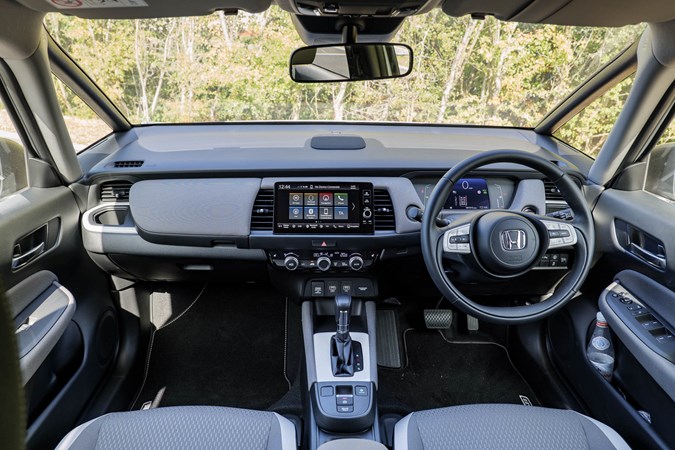
The Jazz’s job is likely to be made very difficult by Honda’s introduction of the e – it’s first fully-electric supermini, and one that’s had a hugely positive reaction to its style and tech from younger buyers.
Which Jazz do we have here?
You may have noticed that the new, fourth-generation (there was technically a Jazz in the 1980s, but we’ll refer to the model line that began in 2001 for clarity) Jazz comes with two very different faces depending on which version you go for.
The basic Jazz gets an interestingly featureless front fascia, which in the right colour gives it more than a whiff of Apple design about it. However, we’ve gone for the ‘lifestyle’ variant instead – the Jazz Crosstar.
With a slightly raised ride height, more conventional front grille and black plastic cladding on the wheelarches to protect against rogue supermarket trolley bashes, this is the range-topper of the Jazz line-up.
As a result, it’s loaded with kit – LED headlights, a 7-inch digital dashboard and 9-inch infotainment screen, climate control, adaptive cruise control and a suite of safety equipment.
Unique to the Crosstar is an upgraded stereo and water-resistant fabric on the seats.
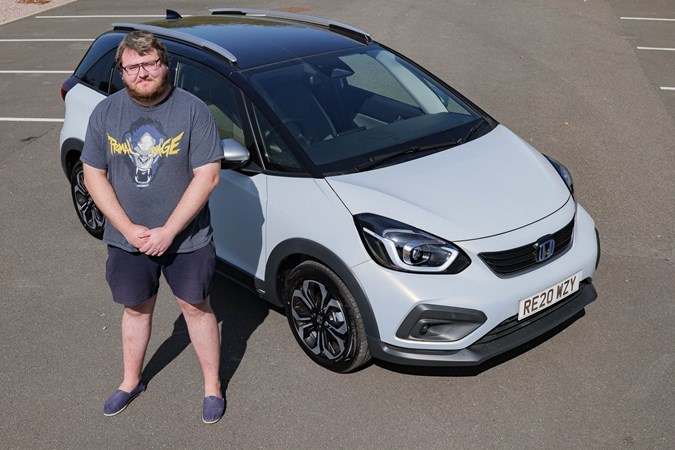
Honda doesn’t offer many optional extras, and as a result our car has none except for two-tone pearlescent white paint with a contrast black roof and a reversing camera.
What’s under the bonnet?
Regardless of your trim level, all Jazzes have the same engine – a 1.5-litre four-cylinder petrol paired up to a battery and electric motor to form a hybrid system.
I’ve just stepped out of six months in a Lexus UX (you can read my reports on that car here) which is also a hybrid, but Honda’s system works differently. I’ll go more in-depth in a later report, but essentially around town the engine operates solely as a generator, leaving the electric motor to drive the wheels by itself.
Then at higher speeds, a single-speed gearbox engages, and the engine links directly with the wheels. It’s a solution that promises impressive efficiency – a promised WLTP mpg figure of 58.8mpg and just 110g/km of CO2.
Unlike some earlier Honda hybrids, this system drives just like an electric car under most conditions – you’ve an automatic gearbox and two pedals, with the focus being on low running costs and isolation from the world around you.
First impressions?
I rather like it. I may be single and childless, but practicality of this sort still excites me, and I’m in love with the Jazz’s ‘Magic’ rear seats, which can either fold totally flat into the floor or lift their bases up to leave a tall, unobstructed load area behind the front seats.
It leaves a genuinely cavernous load area that’s already been well put to use with numerous eBay and Facebook marketplace purchases, both by me and by our very own Richard ‘Selectric’ Kilpatrick, who’s put over a thousand miles on the clock already purchasing old typewriters (and more sensible furniture) from across the country.
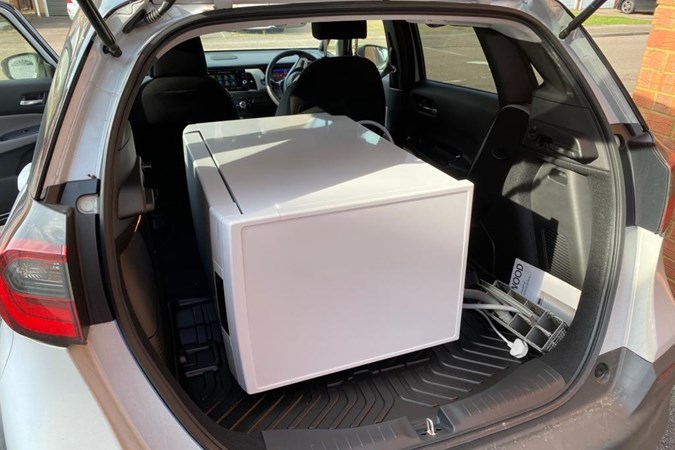
Those long trips highlight the Jazz’s easy nature and comfort, too. Again, I’ll focus more on this in coming weeks, but this is a smooth, relaxing car to spend time in.
It’s proven cheap to run, as well, with the first couple of thousand miles bringing an average fuel economy of nearly 57mpg. I’ve managed to eke that up to 60mpg on some journeys, and will be attempting to beat that as the months go on.
As I write this, we’re heading directly into Lockdown, Episode 2, so the Jazz will be pressed into service for numerous grocery runs and perhaps the occasional visit to a shielding grandparent. I’m sure it will excel, but I’m glad I got in some decent miles before the country shut up shop…
Mileage: 3,167 miles
This month’s economy: 56.7mpg
Update 2: Practicality
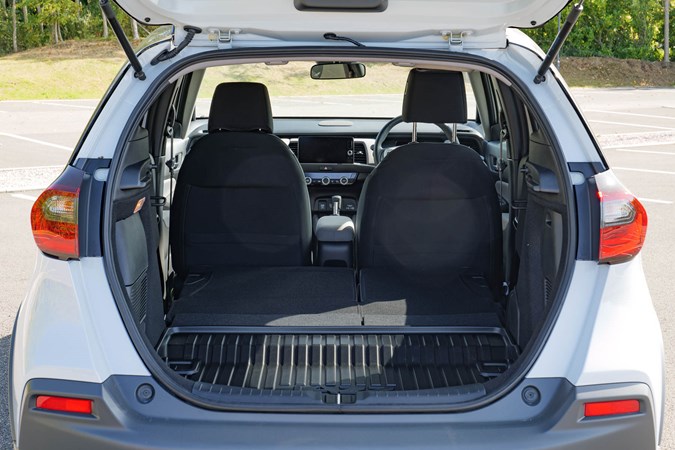
We tend to parrot on about ‘clever’ cars all the time, but often that’s usually whichever model has had the most tech jammed into it by the manufacturer. And sure, big infotainment touchscreens and smart software are all very well, but shoving the equivalent of a laptop computer into a dashboard isn’t really innovation, is it?
With that in mind, I think ‘my’ Honda Jazz might be one of the most genuinely clever cars on sale today. Because in addition to its advanced tech (more on that in a later report) it’s truly innovative in its layout and construction.
And where this pays the biggest dividends is in practicality. Ever since the first Jazz almost two decades ago, Honda’s fitted what it calls ‘magic seats’. By moving the fuel tank from its usual space underneath the rear bench to a new spot further forward, it frees up space for the 60:40 split rear seats to fold down properly into the floor.
These seats were retained for this fourth-generation car, despite its hybrid powertrain, and they’re as good as ever.
Every little seat inside is magic
Instead of the backrest simply tumbling down onto the seat bases, the whole assembly moves downwards, freeing up space to make for a cavernous boot.
Combine this with the Jazz’s MPV-like silhouette – taller and boxier than your average hatchback – and there’s room in here for a staggering amount of stuff. As mentioned earlier, a colleague moving house has already used it to shift plenty of furniture and appliances, and I got my own opportunity to put it to work collecting my Christmas tree just a short while later.
Not only is it the most wonderful time of the year, it’s my absolute favourite – and one I tend to go overboard on. And despite living in a small flat, I do have high ceilings. So the obvious thing to do is to buy an 11-foot Christmas tree, which tested the Jazz to capacity.

And while a scant foot of the crown was forced to hang out of the boot, the amazingly capacious Honda took the rest without complaint. A +1 for Christmas cheer. And significantly easier than getting the tree up my stairs when I got it home…
The seats have another trick – the bases actually flip upwards too, making space for taller items, such as the vacuum cleaners I collect. I’d estimate I could fit four Dysons side-by-side in here. A niche use, I’ll admit, but the space lends itself to all sorts of items – pot plants, bikes, tall cabinets. It’s the kind of space you don’t realise how useful it is until you have it.
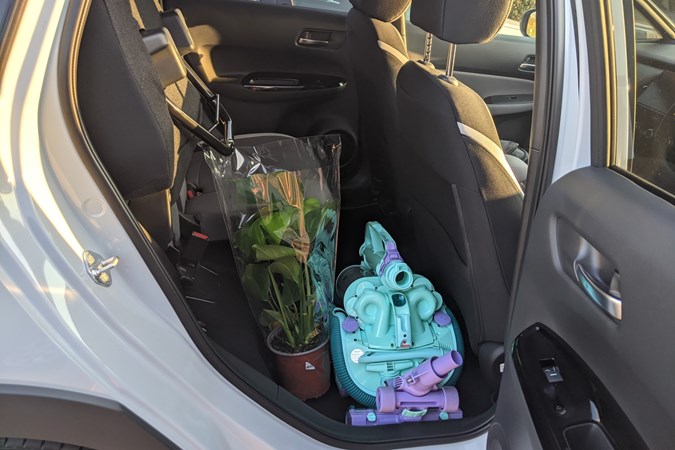
And best of all, when the seats are in their normal position, there’s room for me (at a generously proportioned 6’2) to easily sit behind my own driving position. Back seat passengers are treated to their own USB ports, big windows to look out of and clever smartphone-sized pockets on the back of the front seats. No wonder we decided the Jazz was worthy of being shortlisted for Parkers Small Family Car of the Year, rather than the size class below where it strictly belongs.
>> Parkers Small Family Car of the Year award
It’s certainly a whole order of magnitude more practical than its hybrid hatchback rivals such as the Renault Clio E-Tech or the Toyota Yaris Hybrid.
Practical up front, too
The good storage stuff doesn’t even end at the front seats. The pointy end of the Jazz is just as useful – stuff like twin gloveboxes (a nice throwback to my first ever car, a Peugeot 306… ) and huge cupholders mounted right up on the dashboard remind me that this is an incredibly thoroughly designed car. Another hidden feature is what we’ve dubbed a ‘mini-megabox’ – an underfloor storage compartment, not as large as the Ford Puma’s Megabox where we’ve taken the name from but still highly useful for items you want accessible but out of the way, like de-icer or a first-aid kit.
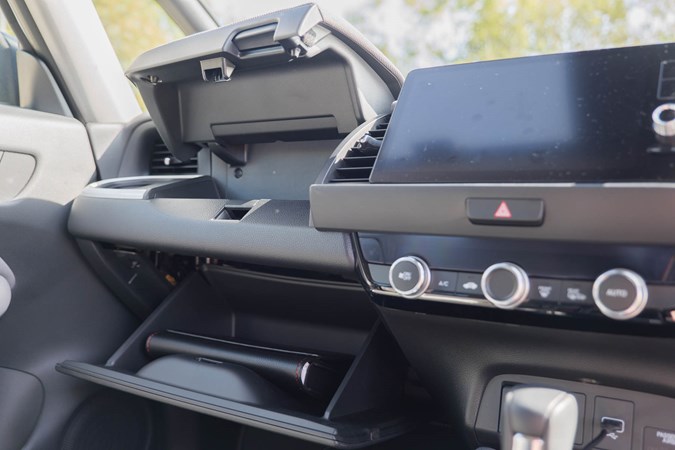
The only things I’m missing? Well, it would be nice to have somewhere tidy to plug my phone in – the USB ports are in front of the gearlever and there’s no covered cubby, so my phone has to sit in its tray with cables trailing. While I’m really having a moan, the large boot could do with some better bag hooks – I like hanging my shopping up. And screw it, let’s get really nit-picky here – the boot light is a dim halogen bulb, while the rest of the interior lights are bright LEDs.
Nevertheless, this sort of practicality is real innovation – I’m amazed no other manufacturer has ever copied it, and I’ll certainly miss it when the Jazz departs a few months into next year. Unless my next long-term tester is an articulated lorry, I’m not sure it’ll be anywhere near as useful for load-lugging.
Mileage: 5,196 miles
This month’s economy: 62.4mpg
Update 3: Interior

I’ll be the first to admit my long-term Honda Jazz Crosstar isn’t much of a looker. The lower-spec, non-Crosstar Jazz has a pleasing sort of mid-2000’s minimalism about it, like an Apple iMac. But with its plastic cladding, glitzy alloy wheels and big fake grille jarring against its mini-MPV silhouette, my Crosstar looks more as though a group of disparate parts have formed an uneasy alliance in Honda’s factory.
But – as I’ve pointed out before – I don’t see much of the outside of my car. That’s something that’s true of most motorists, unless you’ve a particularly dramatic driveway or a lighted plinth in your garage. And from where I sit inside the car, there’s an awful lot to like about the Jazz.
As a colleague pointed out to me on Twitter a while ago, Honda doesn’t do things simply because other manufacturers are doing them. So while the Jazz has all the tech you’d expect from a hatchback in 2021, it’s put together in a package that’s just a bit different from anything else comparable.
Packed with useful touches
To the dashboard, then. You’ll find it’s covered in the same fabric as the seats, giving it rather a different vibe from the usual acres of shiny plastic found in most hatchbacks. That fabric is water-resistant, too – useful for the surfers and active lifestyle types Honda wants to buy its cars, though admittedly the butt of many a joke about incontinent octogenarians. Still, it’s proved as-yet unmarked by numerous small drink spills.

Storage, too, is done a bit differently. There’s the usual large door bins and covered centre cubby hole, but Honda also gives you two cupholders at either end of the dash. Why isn’t this a feature in every car? It’s making use of space that would otherwise be wasted and it places your drink in an incredibly convenient location.
Ditto the twin gloveboxes, the upper of which is easily reachable from the driver’s seat and provides ample storage for my sunglasses, gloves and a stash of face coverings.
I also like that all three sockets – USB connection, USB power and 12V – are located front and centre and easily accessible, though it’s a shame there’s no tidy way to route my phone’s USB cable like there was in my old Civic.
High-tech but not highfalutin
Too often these days we’re presented with vehicles that claim to be just your common or garden family bus – but offer-up features, controls and interfaces for common functions that are insanely opaque. Take the latest Volkswagen Golf, for instance, which routes its climate controls, volume dial and most other essential functions through its touchscreen and an unfathomable touch-sensitive strip underneath it. This from the brand that literally made ‘The People’s Car’!
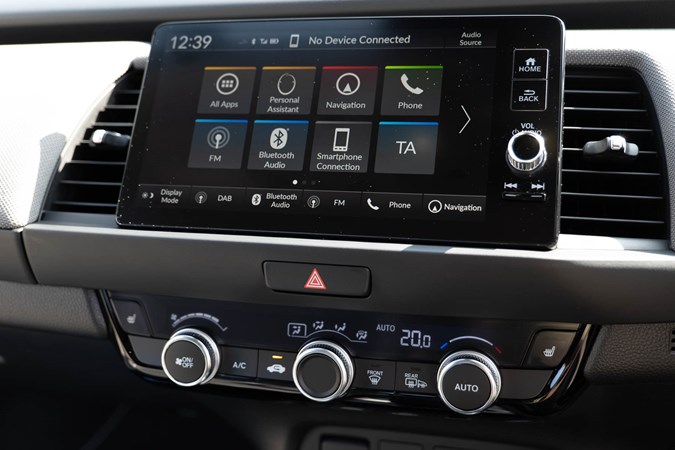
The Jazz eschews any of this trickery and it’s all the better for it. Take the climate control, for instance – it’s three dials, four buttons, and a completely idiot-proof, unobtrusive and legible display. Or take a look at the infotainment. The touchscreen is big, but not dominating – though it’s not very flashy, it’s responsive and easy to use.
The digital instrument panel doesn’t offer myriad display options – instead, it presents the information you want in an easy-to-read format. There’s even an obvious switch to control the brightness of the screens and cabin lighting, which is a real boon for drivers like me who prefer almost total darkness within when driving at night.

No, it’s not perfect – as I mentioned, I’d like a tidier place to keep my phone, and the steering wheel’s a bit of a button-fest. I also find traditional automatic stick shifters to be a waste of space in a car that clearly doesn’t need one – but Honda’s done what it has to do to make the interior as inoffensive as possible to those who aren’t accustomed to the high-tech.
After a few months of ‘ownership’ the Jazz has proven a very reliable companion – and it’s rare that a car with this kind of immense practicality (detailed in my previous report) can also be a really pleasant place to spend time.
Mileage: 5,987 miles
This month’s economy: 56.8mpg
Update 4: Driving
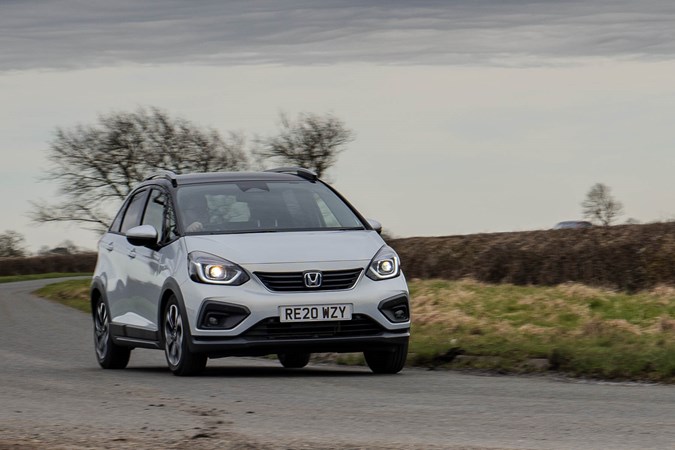
I’ve not really spoken too much about how my Honda Jazz Crosstar drives so far in these reports – because, in a large way, I’m not sure it matters very much.
This little car has so many plus points that as long as it doesn’t drive badly I’d still feel comfortable giving it a wholehearted recommendation.
But it doesn’t drive badly. In fact, in many ways it drives very well indeed – but it’s not going to be ideal for everybody.
Firstly though, what are we dealing with under this car’s diminutive bonnet? Well, as I’ve mentioned before, it’s a hybrid – but it’s a different way of doing things than you might be accustomed to if you’re familiar with the sort of self-charging hybrid system that Toyota’s dominated the market with over the last 20 years.
Perfect for town
At low speeds, the Jazz is for all intents and purposes an electric vehicle with a petrol generator. The engine – a 1.5-litre petrol four-cylinder – never interacts with the wheels. Instead it simply charges a battery which proves power to an electric motor.
This makes the Jazz a truly stellar car for city driving. It’s smooth, it’s quick off the line, it’s quiet, and with no awkward CVT or jerky automatic it’s absolutely effortless.
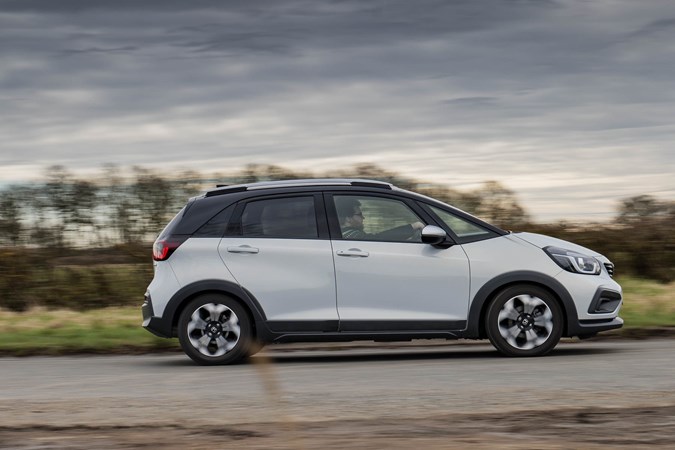
You can even slip the gearlever from its regular ‘D’ into ‘B’ mode, for Battery. This gives a touch more regenerative braking on lifting the throttle, rather like engine braking in a manual, and it gives the battery an extra boost of power each time you slow down.
Driven this way, the Jazz is also amazingly efficient, and on weeks where I’ve little reason to venture outside of Peterborough I’ve been seeing 60+mpg on the trip computer with ease.
If you live in a big city or do most of your commuting across town, you’ll love the Jazz.
Motorway driving
At higher speeds, the Jazz engages a single-speed gearbox and the engine comes into play, driving the wheels directly. This is how ‘my’ Crosstar spends a lot of its time operating.
I’ve been taking regular trips across the country to help my parents out following a car accident. I’m also a compulsive eBay shopper with a tendency to bid before looking at the locations (incidentally, every seller I’ve bought from has been wonderful about zero-contact pickups – a pleasant surprise).
That’s why, despite ‘normal’ journeys halting in their tracks, my cross-country mileage in the Jazz has remained pretty steady, and so I’ve got to know its motorway manners very well.
Sadly, I’ve also got to know its motorway limitations very well – this isn’t the Crosstar’s natural habitat, and it can be hard work at times.
Joining from a sliproad entails rather a lot of whining from the Jazz’s 1.5-litre engine, and the same is true if you attempt an overtake. It’s not dreadful by any stretch of the imagination, but other superminis are much better for this – even, dare I say, Toyota’s hybrid Yaris.
Motorway miles also see the Honda’s fuel economy tumble, and even sticking religiously to 70mph you’ll find 50mpg an achievement.
Its high sides are also rather susceptible to crosswinds and the adaptive cruise control – a feature that’s usually a boon to motorway driving – is too sensitive even on its closest setting, braking the car while I’m still miles away from traffic in front.
But what about the twisty bits in between the towns and the motorways? There’s not really a great deal to say about this – the Jazz is competent, but it’s not exciting. The tall body rolls rather a lot, and while the steering is light and really pleasingly accurate the thin-rimmed steering wheel offers next to no feedback.
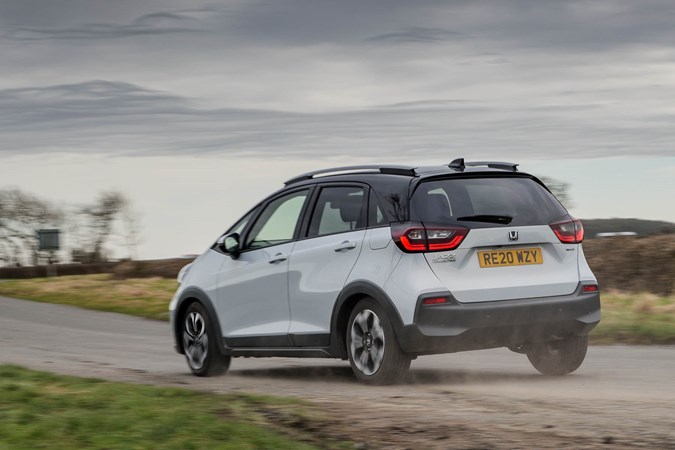
Combine that with very little grip available from the efficiency-biased tyres and the engine’s resistance to any sort of enthusiasm and it’s fair to say we’re not likely to see a Jazz Sport any time soon.
Does this matter? No, not really. Sensible is the name of the game, and sensible cars don’t need to be sporty. Sensible cars need to make boring journeys effortless, and by and large that’s what the Jazz does.
My time with it is rapidly drawing to a close, and my next car does most of its thinking inside the box that Honda so steadfastly refuses to put the Jazz in. I just know I’m going to miss it.
Mileage: 6,732
This month’s economy: 52.1mpg
Update 5: Alternative Jazz
As my time with the Jazz Crosstar draws to a close I’ve forced myself to have a really good think about its positioning – in relation to other models in the Jazz range, in relation to other Hondas, and in relation to other small hatchbacks and crossovers as a whole.
The problem is, that’s a really tricky thing to do.
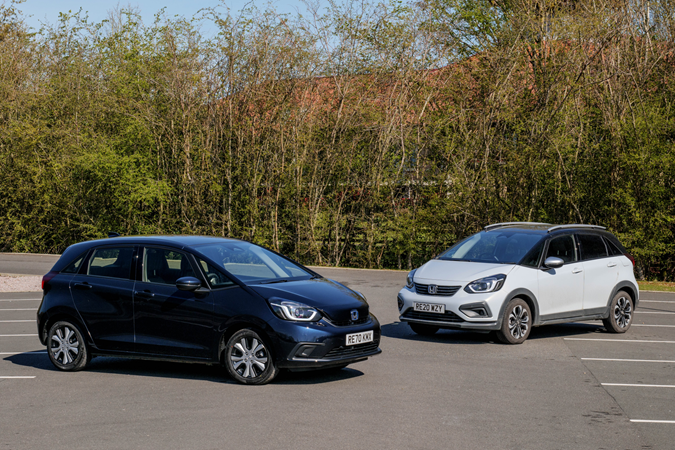
Comparing it to its own sibling is perhaps the easiest thing to do. Crosstar is, in most ways, the range-topping trim level to the Jazz range. Its siblings do without the black plastic cladding, but they also make do without such a pleasant interior. This mid-spec model has a frankly awful plastic steering wheel and fake leather dash. For me, the cost-saving isn’t worth it. There, that was simple.
The Jazz has always straddled market segments. Since launch, it’s been the size of a supermini but with interior space to rival a small family car – and that’s exactly the case with this model. It’s so practical that when it came to the 2020 Parkers Car Awards, we gave the Jazz an honourable mention in the Best Small Family Car class, next to the likes of the Ford Puma – that is, a compact SUV.
And it’s these compact SUVs that I think really suffer when you take an objective look at what they offer compared with the Jazz – but then, so do its hatchback rivals.
Honda Jazz vs the compact SUV
Practicality. A compact SUV like a Puma, a Peugeot 2008 or a Renault Captur is simply nothing like as clever or as space-efficient as my Jazz for a given length and price.
While I (at about 6’3) can sit comfortably behind my own driving position in the Jazz, I can’t in its rivals. A few months ago, I borrowed a recliner chair from my parents – it fitted easily into the back of the Jazz with room to spare, but when I returned it in a Peugeot 2008 it barely squeezed under the roof. The two cars are similar heights – but the Jazz has a lowered floor giving it way more vertical space in the rear.
I’ve banged on about the magic seats before, and I’ll do it again. The versatility they offer is astounding. Not only do they tumble properly into the floor (rather than the seatbacks simply flopping down onto the base, they lower themselves into the footwells) making for that incredible loading height I just mentioned, but when the bases are flipped up they’re a fantastically useful way to carry tall items that ought not be stored on their side. Plant pots and a whole array of vacuum cleaners have been transported this way.
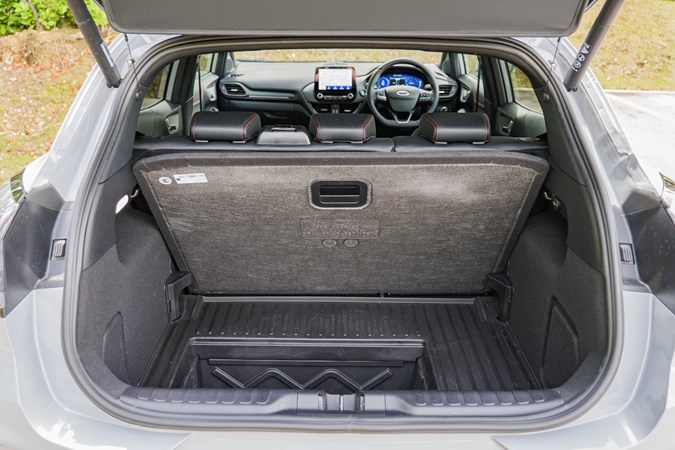
The Jazz is no speed demon and there’s only one engine option, but its self-charging hybrid drivetrain is just as satisfying and easy to drive as any similarly powered compact SUV. And the price? Comparable to the high end, which is often where you’d need to end up before you can spec an automatic gearbox.
Even with the SUV-alike exterior additions that Crosstar brings, the Jazz doesn’t have the same style as these crossovers. But I think it’s a fairer comparison than it appears. People upgrade from their superminis into a compact SUV like these for greater space and practicality – for increased accessibility if they have child seats to do battle with or dicky hips that object to lowering themselves down too far.
If these are the reasons and style isn’t much of a concern, the Jazz is – put simply – a better car.
Honda Jazz vs the hybrid hatchback
There are currently two other hybrid superminis on the market vying for the same slice of the pie as the Jazz. The Toyota Yaris and the Renault Clio E-Tech both use a totally different hybrid system to the Honda, and both have their strengths and weaknesses.
First blood goes Jazzward – both alternatives are much smaller and less practical. Obviously. For the interior and dashboard, it’s much closer – I like both the Jazz’s expansive simplicity and the Renault’s driver-focused setup, so we’ll call that one a tie. Unfortunately Toyota’s infotainment system is still dreadful, and I don’t much care for the material choices inside.
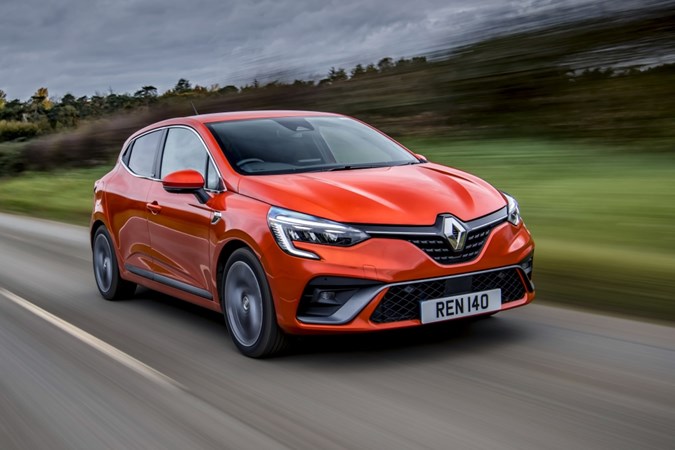
In terms of MPG and running costs, it’s points to both Renault and Yaris. The Jazz returns an official 58.8mpg compared to the Clio’s 64.2mpg and the Yaris’ 68.8mpg. In the case of the Clio, that’s especially impressive as it’s a significant amount more powerful than the other two.
Not that any of these cars should prove expensive to run, and over my time with the Jazz I’ve regularly beaten that WLTP figure on trips around town. But, I assume by virtue of its extra weight, you’ll spend more on fuel with the Jazz – plus, despite Honda’s amazing reliability record, it only offers three years of warranty cover compared to the other two’s five.
The Honda does lose out rather on driving dynamics, though. The other two cars are lower, leaner and generally more fun – the Yaris particularly. Its hybrid system is more pleasant to drive quickly, with more linear responses and a nicer engine note at higher revs.
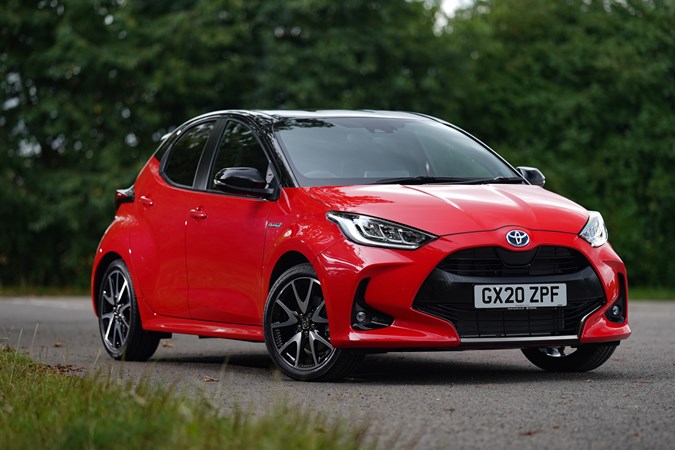
The Clio’s the most powerful of the lot, but its hybrid powertrain is very jerky, especially at low speeds, and that’s a real annoyance for a car that’s supposed to excel in town.
At a similar price for top-spec models (around £24,000) the Honda still makes a very strong case for itself – costing ever so slightly more to run, but being vastly more versatile and, I think, nicer to sit in.
Honda Jazz vs Richard Kilpatrick
It’s not just me who’s been driving the Jazz. Almost as soon as I got it, Consumer Editor Richard Kilpatrick borrowed it and started slapping on the miles – and he’s also been driving it since his Mercedes-Benz CLA Shooting Brake test car went back to the manufacturer. His thoughts follow…
“After a car with a somewhat confused identity, the Jazz is an immensely focused little thing; it is, perhaps, one of the cleverest small cars you could buy – but it’s not what you’d call ‘cool’. The Crosstar tips the balance, and I love the ‘80s sci-fi view out of the large, flat windscreen. In my imagination, the rugged arches and wedge shape turn it into a little shuttle for exploring, and it just works. Although it lacks seat adjustment compared with many European rivals, what it has is comfortable for longer trips, and there’s some excellent attention to detail – for example, when using voice control, if the air conditioning is working hard, it slows the fan to hear you properly.
“Economy and performance are more than acceptable to tempt you out of a smaller-engined diesel, and the use of a proper lever removes the weird lag when swapping from forward to reverse that many hybrids and EVs display from their toggle switches. Tom’s already covered the practicality; it’s exceptional for a car of this length.
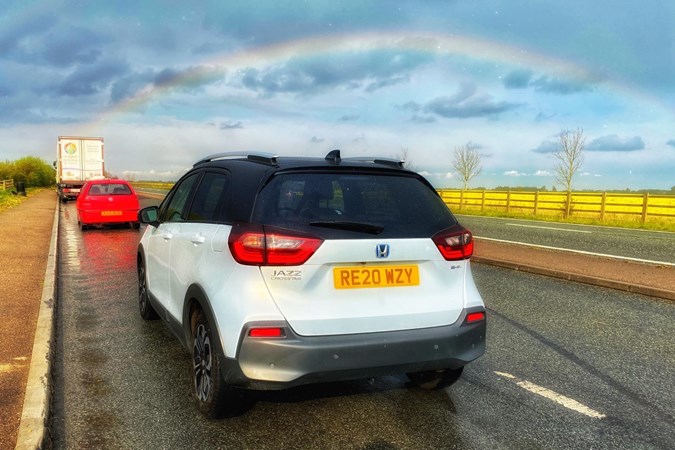
“It’s not perfect – the wireless Apple CarPlay is weirdly laggy and slightly pointless without a charging pad – but then you find the adaptive cruise and lane keeping that will happily follow and steer behind an HGV in heavy motorway traffic without scaring you (the lane-keeping is less helpful on narrow country roads), making long journeys quite relaxing.
“It’s an odd value equation – £24,000 still gets a lot of car if you look to SUVs from Nissan or SEAT for example – but it’s clever, well-engineered, rather than just armfuls of metal and kit for your money. The interior is rattle free. The economy is delivered consistently. All the rumours of an Apple car could have lead right here – slightly expensive, slightly anonymous to look at, but it just works.
“It may not flatter the ego or project your personality, but it’s a very likeable and effective car. I’m going to miss it.”
Me too, Richard.
Mileage: 7,400
This month’s economy: 54.4mpg
Update 6: Farewell
We say a sad goodbye to the Honda Jazz Crosstar – it’s been a surprise hit among the Parkers team
Giving the keys to our long-term Jazz Crosstar back to Honda is a wrench, I’ll tell you. I’ve run a fair few long-term test cars now, but the Jazz is by a considerable margin my favourite.
You only need to look back at the reports above to get a sense for how badly I’ve fallen for this clever little box of tricks. It’s immensely practical. It’s high-tech without being intimidating. It’s relaxing and comfortable to drive, but returns good fuel economy into the bargain.

What’s more difficult to quantify but obvious (and corroborated by reports from those on the team who’ve also driven it) is that the little Honda is also utterly charming and characterful, occupying more of a place in one’s heart than perhaps should be expected.
And given that by any objective measure, this is all the car most people could ever reasonably need, why aren’t the UK’s streets a veritable Jazz festival?
Style matters
I suspect that the Jazz’s image counts against it, despite Honda successfully reinventing it for its fourth generation. I like its plain, unfussy exterior design – but it can’t hide that the Jazz is anything but lean and lithe.
Compared with the handsome Ford Fiesta or stylish Peugeot 208, there’s not a lot of competition in terms of car park bragging rights. Perhaps, in time, cars like the e will help the Jazz escape its blue-rinse preconceptions, but that hasn’t happened just yet.
Minor annoyances
No relationship is perfect and there are a few moans I’ve had regarding the Jazz – none big enough to merit their own reports, though.
The main annoyance has been with the driver aids, particularly lane-keeping assist. It’s simply too skittish for the narrow Fenland roads I spend a lot of my time on, actively steering me back to the centre of the road if I’ve moved towards the edge to pass someone, for example.

This leads to a lot of unnecessary wrestling with the wheel and a few slightly hairy moments. You can turn lane-keeping off, via a fairly easy menu in the instrument display, but you shouldn’t need to – the best systems can remain unobtrusive until they’re needed in an emergency.
The lane-keeping’s also been a point of (minor) failure – throwing up an error message fairly regularly. As it immediately works again after being turned off and on, it’s not something I’ve felt the need to get seen to by a dealer, but if you own a Jazz and have the same problem do bring it up at service time.
Overall fuel economy has been good but I’ve found it disappointing on longer trips. Stellar running costs around town and for short trips is a great thing, don’t get me wrong – but with the amount of longer journeys I do, it’s a personal bugbear.
Final thoughts – would I recommend a Honda Jazz Crosstar?
Would and have. I think the Jazz’s function-over-form mantra makes it unique, special and incredibly accomplished.
It’s perfect for small families, single people who regularly carry large loads or anybody who just wants something efficient and superbly easy to drive for quick trips around town.

It’s a shame that non-Crosstar variants of the Jazz have such a miserable interior. That alone would make me recommend this range-topper, despite its comparatively high price tag. However, that’s only in comparison to other superminis, where the Jazz has the space and practicality to rival compact SUVs (as I mentioned further up this page). Compared with those, it’s pretty well-priced.
Other members of the Parkers team agree with me that the Honda Jazz is somewhat of an underappreciated gem – everybody who’s driven it has been full of praise. It’s been an absolute pleasure to ‘own’ and to drive over the last six months, and I’m genuinely sad to see it depart.
Final mileage: 8,012 miles
Overall fuel consumption: 56.4mpg



